Not only is rhubarb an attractive perennial and a delicious springtime treat, it’s very easy to grow from rhubarb crowns and, with a little knowhow, can even be forced to crop early. Here are some of the best articles, videos and Instagram posts to help you successfully grow and harvest your own tangy and nutritious crop.
Contents:
How to plant rhubarb
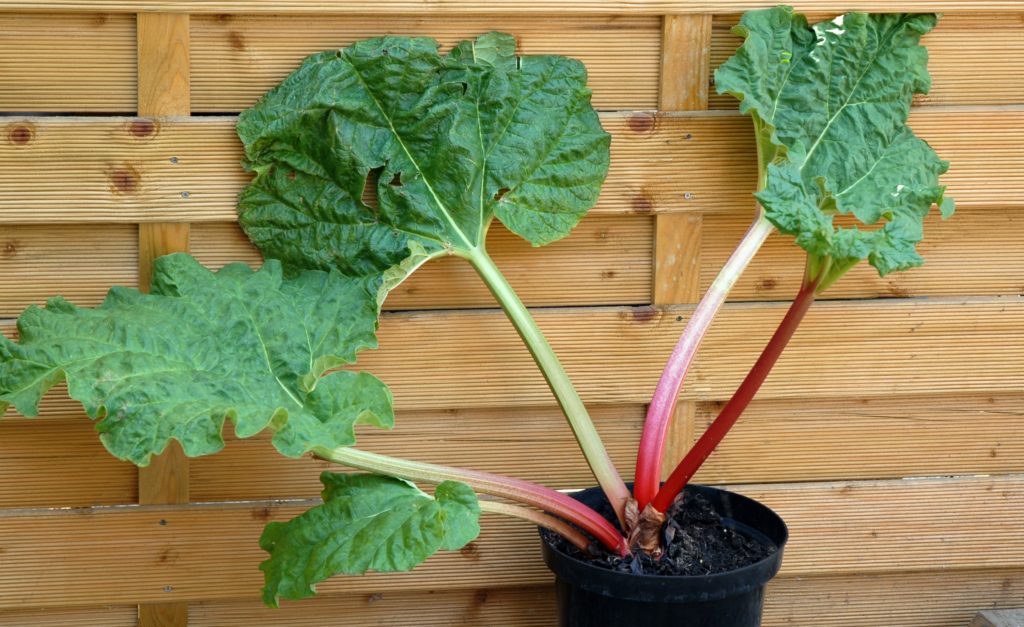
Image: Rhubarb crowns ‘Thompsons Terrifically Tasty’ from Suttons
Rhubarb suits sun or partial shade, but give some serious thought to where you plant it as it will be with you for a long time, hates being moved and can grow quite large, says Katharine Woods at The Teabreak Gardener: “The leaves can be a statuesque 60-80cm across on 60cm stems.” Katharine loves the big, tropical-looking leaves so much, she thinks they “are attractive enough to have a place in a garden border amongst flowers and shrubs.”
To get the ground ready to receive your rhubarb crowns, Tony O’Neill at Simplify Gardening offers an excellent video to help you prepare the soil correctly. His secret recipe for soil improvement features chicken pellets because a leafy veg like rhubarb needs lots of nitrogen. He says you’ll also need a good general compost, sulphate of potash and a good mulch of well-rotted bark to finish it off.
Provided the ground isn’t waterlogged or frozen, you should plant your rhubarb crowns as soon as possible after delivery, says our team of horticultural experts here at Suttons. The best time to plant rhubarb is from October to November and during February and March. Rhubarb is very easy to plant – simply dig it in leaving just the very tip of the crown protruding from the soil.
“Rhubarb does grow well in pots, but make sure they’re big’uns to accommodate the chunky roots,” says Naomi Schillinger from Out Of My Shed. If growing this way, Naomi recommends that you fill your containers with “tons of rich compost” and feed your plants with pelleted manure. Naomi uses upcycled dustbins as containers for her rhubarb – check out her post to see just how well her plants thrive.
Are you tempted to try growing rhubarb from seed? It can be done, explains veg guru Huw Richards on his YouTube channel. He recommends sowing into a well-sieved combination of 50% potting mix and 50% soil and using a sheltered greenhouse or polytunnel to germinate. As he explains in his excellent video, growing this way takes a little longer before you’re ready to harvest but it’s well worth the effort.
How to care for rhubarb
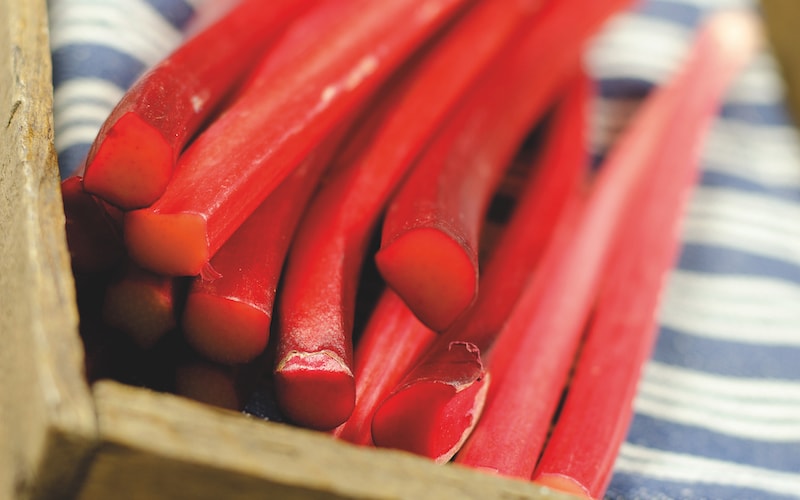
Image: Rhubarb crowns ‘Rheum Champagne’ from Suttons
To maximise your crop of rhubarb stems, you should keep a close watch for signs that your plant is beginning to bloom. Over at Grow Veg, expert grower, Benedict Vanheems says:
“Remove any flowers as they appear to keep the crown producing those delicious stems. Keep plants well-watered in dry weather, especially while they’re settling in, and cut back all the leaves and stems at the end of the growing season.”
If you notice your rhubarb plants struggling, it might be time to divide them, says Tanya at Lovely Greens. You should do this roughly every five years, waiting for the plant’s dormant phase to divide and replant. Take a look at Tanya’s video in which she demonstrates her clever method for dividing rhubarb. She never lifts the whole plant, but instead uses a sharp spade to slice through the crown while it’s still in the ground.
If you’ve decided to divide your rhubarb, the centre is the part you’ll probably want to cast aside, says Marie of @plewsgd. She recommends waiting until October to tackle plants that have begun to crop less vigorously: “Keep the younger, more productive outer sections and replant them, adding some well rotted compost as a mulch.”
How to force rhubarb
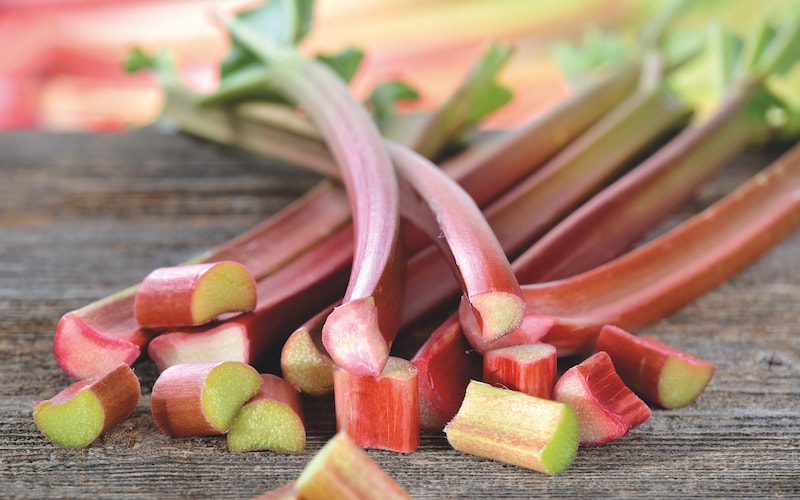
Image: Rhubarb crowns ‘Sanvitos Early’ from Suttons
Would you like to learn how to force rhubarb? Before you begin, we recommend a visit to Plews Garden Design where professional gardener Marie discusses the ‘Yorkshire rhubarb triangle’ and explores the rich history of forcing. She explains that this horticultural trick was actually discovered in 1817 by accident at the Chelsea Physic Garden, “when some rhubarb crowns were covered with soil over winter and the resulting stems were found growing earlier than the rest of the rhubarb.”
“Forced rhubarb produces a really sweet and tender crop,” says John Harrison at Allotment & Gardens. Here he details his instructions for growing stems this way: “Place a large container (such as a black plastic dustbin) over the plant as soon as it sprouts in late winter/early spring. The extra warmth promotes growth and pale, tender stalks after about four weeks.” If you do decide to give forcing a go, he advises rotating the plants you force each year to avoid exhausting any one plant.
If you’d like to see what forced rhubarb shoots look like, head over to @robsallotment where grower Rob Smith showcases his own efforts. “No, it’s not from an Alien movie,” he says! “This is the first of my forced rhubarb that’s just starting to ‘pop’ open. I covered the crowns with an old forcer to encourage the stems to be light pink, tender and delicious (you could use an old bin)”
How to harvest and enjoy rhubarb
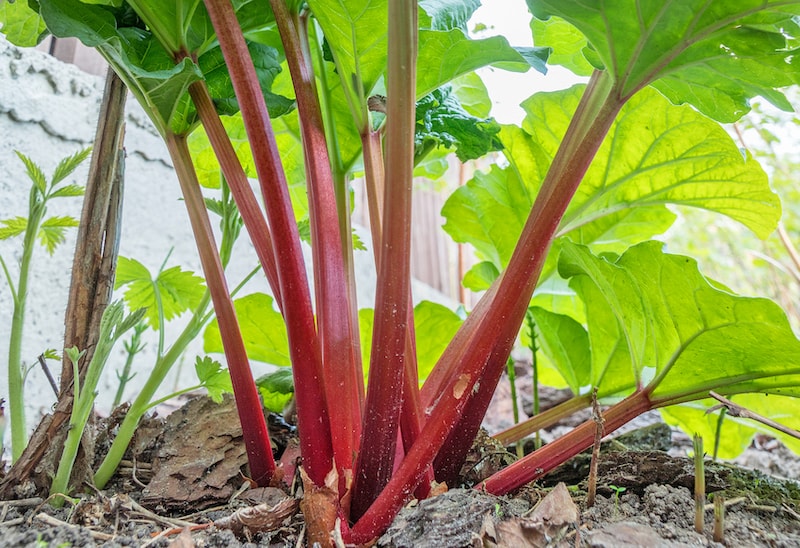
Image: Rhubarb crowns ‘Polish Raspberry’ from Suttons
Ready to harvest your rhubarb? “Stems should be pulled rather than cut to prevent rotting of the remaining stump,” says the team at Brighton & Hove Allotment Federation. Their recommendation is to “pull stems when they’re between 23-30cm (9-12in) long, holding them at the base and pulling gently outwards.” A great site with lots of information for budding gardeners, we highly recommend these guys for their very generous sharing of gardening help and knowhow.
Some like to pick their rhubarb when it’s big, while others like Chris of @glos_allotmenteer like it small and tender. While you’re checking out his gorgeous Insta, take a peek at his “most amazing and simple fermented rhubarb recipe.” Perfect with a cheese ploughman’s or curry, it’s an unusual use for rhubarb, but well worth a shot.
Join Kev at The English Homestead as he experiments with dehydrating rhubarb. Using a dehumidifier, he says his batch was dry in around 13 hours and, although it looks comically small when done, don’t let appearances fool you. It really packs a punch when you add it to your overnight oats. According to Kev it had the texture of a currant, a sharp flavour, and made a healthy addition to breakfast.
Anyone for rhubarb buttermilk muffins? Over at The Marmalade Teapot, Katie shares her wonderful recipe. She says, “the buttermilk makes these muffins so tender, moist & light. With a jammy little burst of rhubarb throughout and a crunchy demerara topping, these are very addictive.” For a more traditional serving suggestion, try Katie’s rhubarb jam.
Finally had enough rhubarb crumble? If such an unlikely event were ever to occur, Tanya at Lovely Greens has the ultimate solution. “When this happens, you know it’s time. Time to make homemade rhubarb wine.” For full instructions, head over to her blog. She says she only made one batch last year which was a “tragedy.” Why? She definitely should have made more!
With a little help from these expert growers, we hope you’re well equipped to tackle the challenge of raising your own delicious spring rhubarb crop. And don’t forget, if you’re looking for more information and advice, check out our Growing Guides.
Lead image: Rhubarb crowns ‘Timperley Early’ from Suttons
Last Updated on November 8, 2024 by Suttons Horticultural Team

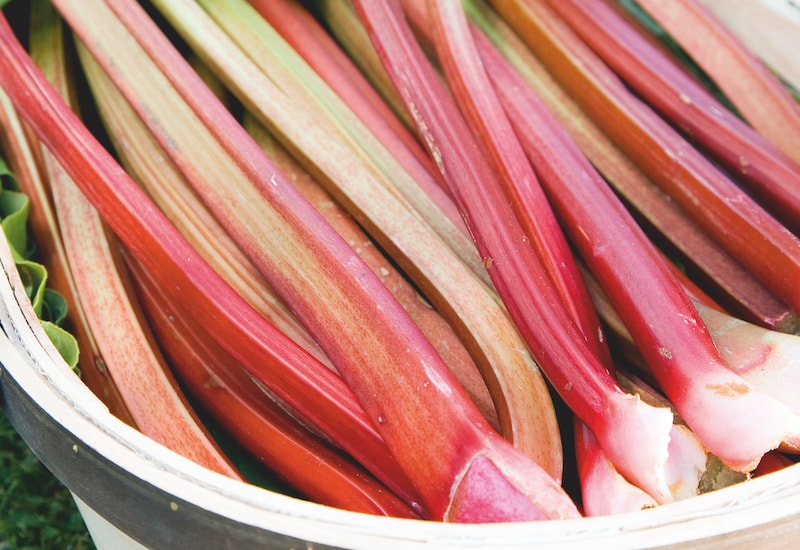




The stems of my rhubarb have a number of clear tiny crystals on them – is it still okay to eat?